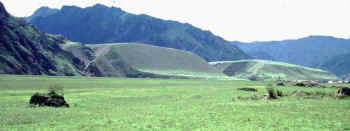|
(Extended abstract for meeting of Italian Sed. Res. Group, Potenza, Italy,
August 2002)
Geomorphic and sedimentological features of upper Quaternary megafloods
compared with seasonal, large meltwater floods
I.P. MARTINI1 , S. PARNACHOV2 and P.A. CARLING3
1
Department of Land Resource Science, University of Guelph, Guelph, ON
Canada.
2Department of Geology and Geography, Tomsk State
University, 634050 Tomsk, Russia; Department of Geography, Highfield, University
of Southampton, Southampton, Southampton, G.B.
 Over the last century or so the concept of catastrophic events and diluvial
flood(s) has been first replaced by the concept of worldwide glaciations, to
return with avenge for certain cases. The question remains on what is the
geological evidence to discriminate between rare catastrophic megafloods and
large, rather common glacier meltwater floods or man-induced events such as
those associated with hydroelectric reservoirs. Over the last century or so the concept of catastrophic events and diluvial
flood(s) has been first replaced by the concept of worldwide glaciations, to
return with avenge for certain cases. The question remains on what is the
geological evidence to discriminate between rare catastrophic megafloods and
large, rather common glacier meltwater floods or man-induced events such as
those associated with hydroelectric reservoirs.
Late Quaternary, catastrophic megafloods associated with breaks of icy dams
of glacial lakes are well documented in Washington State (USA) and in the Altai
Mountains in south--central Siberia. The latter will be briefly analyzed and
geomorphologic and sedimentological features will be compared and contrasted
with those of glacial meltwater and man-induced floods of Ontario, Canada. The
geological history and settings of these areas are different, but most resultant
features are comparable except for their scale, being orders of magnitude
greater in the case of the Siberian megafloods.
The evidence of megafloods includes the following:
Erosion features: Formation of deep canyons, channeled scablands locally
showing anastomosing dry valleys, streamlined hills supposedly eroded by
cataclysmic floods, elongated depressions now lakes, very large scour marks
around obstructions such as large boulders, formation of kettles (depressions)
possibly associated with melting of rafted ice blocks on top of giant gravel
bars.
Depositional features: In proximal areas the main features are the
scatter of boulders on channel floors and on terraces, the formation of giant
(up to 5 km long and 120 m high) gravelly junction bars at the entrance of
tributary valleys, giant gravely current ripples (dunes with well developed
internal cross bedding) (Fig. 1) found on terraces and on top of the large
junction bars, thick lacustrine deposits formed in side valleys dammed by
gigantic bars, development of large Gilbert-like deltas possibly associated with
a single of few flood events.
In distal areas
the evidence is less well defined. However
powerful and sediment charged is the flood flow, it may loose it capacity and
competence rapidly as it enters a terrestrial or subaqueous basins. Recently,
tentative correlations have been made been made to correlate possible Missoula
megafloods of Washington State with turbidities layers of the adjacent Astoria
subPacific fan. Similarly, glacio-lacustrine successions have been analyzed in
details in the Great Lakes of North America to try and determine whether
anomalous thick rhythmites occur which might be associated with meltwater
megafloods. Some of these correlations may be valid, but problems persist in (1)
the difficult task of time-correlating terrestrial and subaqueous stratigraphic
units, let alone relatively thin stacks of beds, (2) in being able to determine
whether a succession of deep water rhythmites have been deposited by multiple
floods or by a pulsating megaflood, and (3) evaluating the preservation
potential of shallow water deposits. An example of the latter case is the local
rapid 12 m seaward progradation of the southern coast (widespread braided delta)
of Iceland during the 1996 large flood, subsequently eroded and pared down by
the ongoing normal costal processes.
Difficulty in recognizing megafloods and the fact that in some cases
alternative hypotheses exist, such as more gradual switching of flows at a
continental scale, do not diminish the probability of their occurrence as rare
events that may have had temporary significant effects on Earth's environments.
These include sudden changes in the salinity, isotope composition and
temperature of large bodies of water, such as the Gulf of St. Lawrence, the Gulf
of Mexico, the Aral Sea and possibly the Caspian Sea, locally triggering of mass
mortalities of shelf organisms, and perhaps the onset of a renewed local, cold,
terrestrial climate, such as the Younger Dryas along the eastern shores of
Canada. Sudden shift of large masses of water may have also triggered local
rapid isostatic readjustment of vast areas such as those of central North
America (former Lake Agassiz) and parts of the Great Lakes of North America).
Nevertheless, however appealing is speculating on the occurrence of such
megafloods and their potential effects, the facts still stand that they are rare
events, that they produce local erosion and depositional features much similar
to those of other recurring large floods, albeit at a larger scale, and that
their deposits may be well preserved in deeper parts of the basins but they are
mostly obliterated in terrestrial and coastal settings.
¡¡
|